Martin Edwards's Blog, page 59
April 26, 2022
The CWA Conference - Torquay 2022

Last weekend Mrs Edwards and I made the long journey to Devon to join the CWA's annual conference at the splendidly located Imperial Hotel in Torquay (the photo shows 'London Bridge', a rock formation just around the corner). I say 'annual', but because of the pandemic, this was the first conference since Windermere in 2019, which also marked the end of my time as Chair of the CWA. To be able to see so many old friends (and meet some lovely people for the first time) was a joy. Zoom is great, but there is something special about being able to share jokes and stories with other people in person.
Incredibly, 32 years have passed since I first attended a CWA conference in Torquay - that one coincided with the celebrations connected with the Agatha Christie centenary and it was a truly memorable occasion, with a trip to Greenway, still at that time owned by Agatha's daughter: it was my only encounter with her. This time, the organisation of the conference was overseen by Michael Jecks. He and his team did a terrific job. The fact that I've been involved with helping to organise a number of recent conferences gives me an added appreciation of the work that goes into making things run smoothly. It's not an easy job and I must say that I relished not having any responsibility this time - other than to enjoy myself.
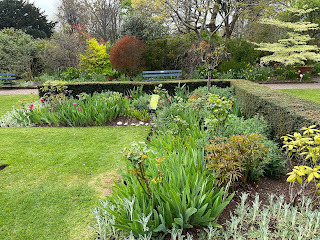
Another trip to Greenway was on the programme this time, but having stayed there not so long ago, we opted to explore Torre Abbey instead. When I've been in Torquay in recent years giving talks at the Agatha Christie Festival in the Spanish Barn in the Abbey grounds, I've never had time to look round the place properly. It was definitely worth doing - and visiting the Agatha Christie Poison garden was a special bonus - see the photo above.
At the conference itself, there was a wide range of talks. Perhaps the stand-out was Harry Tangye (nephew of Derek), an excellent speaker, but I was also very taken with an ex-cop and jailbird turned cagefighter who has, in the time-honoured phrase 'turned his life around'. On Friday evening there was a reception at the local museum, which has one room dedicated to Agatha. The after dinner speaker at the banquet on Saturday evening was Victoria Dowd, who will be joining me on a panel at CrimeFest before long. Allan Martin kindly inscribed a copy of his new book for me, while I was glad to hear, among other things, that Derek Webb's plays are going great guns, as are Maxim Jakubowski's anthologies. I enjoyed a fascinating banquet chat with Stella Jakobi and also a meal with Frances Brody, Kate Ellis and Christine Poulson. It was also good to see Keith Miles and Cath Staincliffe on the longlist for the Dagger in the Library. All in all, great fun.
April 22, 2022
Forgotten Book - In Face of the Verdict
In Face of the Verdict is a Dr Priestley novel which John Rhode published in 1936. It's an uncommon title and I was pleased to lay my hands on a White Circle paperback edition. Rhode was probably at the height of his powers at around this time, so it was a novel which I looked forward to reading. As it turned out, it is most interesting as an example of Rhode's craft as a detective novelist, and the strengths and weaknesses of his methods.
The blurb says: 'The sheer ingenuity of Mr John Rhode is deservedly a matter for enthusiasm. He is certainly one of our more resourceful providers of puzzles that are real brain-teasers.' In this case, Major Walter Bedworthy (great name; no jokes, please) is found dead, and the inquest verdict, to which the title of the novel refers, is 'Accidental death by drowning'. But his friend Sir John Hallatrow isn't convinced, and he summons assistance from Priestley.
A few days later, the Major's brother, one Ernest Bedworthy, also drowns. You don't have to be Dr Priestley to conclude that there's no coincidence here. But, as usual with Rhode, the question is how did the killer commit the crimes? As the story proceeds, Rhode takes the opportunity to poke fun at temperance and telepathy (he clearly equates the latter with spiritualism) - he was a strictly practical chap who liked his beer, after all.
The murder method is elaborate and difficult to figure out, especially if like me you don't have a practical turn of mind. But I'm afraid I didn't care enough to try to solve the puzzle. Agatha Christie's skills at characterisation are often criticised, but compared to Rhode, she created in-depth people. It's clear that the starting point for the story was a clever m.o., but the way Rhode handled it meant that the culprit is a shadowy figure, while two wearisome red herring suspects take centre stage. Disappointing.
April 19, 2022
Francis Durbridge - La Boutique and The Scarf
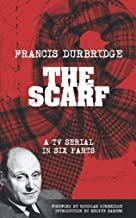
In a guest post on this blog last month, Melvyn Barnes explained the work he'd been doing with the estate of Francis Durbridge and that enterprising small press Williams and Whiting to bring to print a good many of Durbridge's stories for TV and radio. I'm a Durbridge fan and I think this is a very worthwhile project indeed.
I was especially interested to read La Boutique, a radio serial in five parts which hadn't previously registered on my radar. The book contains the original scripts, which were especially commissioned by the European Broadcasting Union. As Melvyn points out in his intro, the story was written in 1967 and Durbridge was the first author to be invited by the EBU to write a radio serial for multi-lingual broadcasting. It shows how popular he was across the continent at that time.
La Boutique is a classic Durbridge mystery, with many of the tropes we know and love in evidence. The starting point is a meeting between Robert Bristol, a cop, and his songwriter brother Lewis. Lewis tells (with the aid of flashback scenes) the story of how he became infatuated with Virginia, whom he met in the US - only for her to disappear in highly mysterious circumstances. There's also a puzzle about a missing belt from a dress shop, La Boutique, owned by Lewis's ex-wife Eve. The plot thickens when a corpse is found - with the missing belt . A classic Durbridge cliffhanger to end episode one. I very much enjoyed this story.
The Scarf was a TV serial which was hugely popular back in 1959: it was shown on BBC TV in six thirty-minute episodes, with Donald Pleasence playing Inspector Yates and a cast which boasted the likes of Patrick Troughton and Anthony Valentine. A young woman called Fay Collins is found strangled on a farm tractor trailer and suspicion falls on a publisher called Clifton Morris. It's another story in the vintage Durbridge mould - the eponymous scarf adds to the puzzle, rather like the belt and a photograph of the shop in La Boutique, like the doll in The Doll, and so on...TV scripts aren't as easy to read as radio scripts in my opinion, because of the visual component, but this is an interesting story that is sure to entertain Durbridge fans.
April 18, 2022
Death of the Living Dead by Masaya Yamaguchi
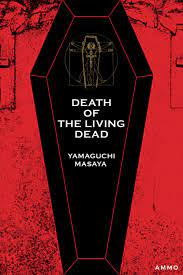
In the last few years, I've become increasingly fascinated by the inventiveness of Asian crime fiction. Even before my trip to Shanghai in 2019, I'd been reading a range of mysteries from the Far East which, although often very different from familiar western detective fiction, and sometimes quite outlandish, are often very appealing. Meeting Soji Shimada served to strengthen my interest in Japanese detective fiction, as did conversations with the critic and writer Steve Steinbock, who speaks Japanese and is a great fan of the country's crime writing. Their enthusiasm is infectious. Coincidentally, I've begun to have books of mine translated into languages such as Chinese, Japanese, and Korean, which I find exciting.
I was, therefore, pleased, when I was contacted a few weeks ago by Masaya Yamaguchi, whom I've never met in person, but with whom I've been in touch for a while. He invited me to take a look at the newly published English translation - by Ho-Ling Wong - of his celebrated debut novel, Death of the Living Dead. and originally published back in 1989. This is a long book, unusual in structure and quite unlike any detective story I've read before.
As other commentators have already pointed out, this is a hard book to review, because of its extraordinary nature. But I can understand why a number of bloggers have enthused about it: see, for instance, the laudatory review on that excellent blog, The Grandest Game in the World. And as someone who has spent most of his life in Cheshire, it amused me that one of the key characters is called...Cheshire.
As the title suggests, this is a story about zombies, and that may put off some readers, who insist on rationality in their detection. But I think it's true to say that, within his own surreal universe, Masaya Yamaguchi plays fair with his readers in a truly mind-spinning mystery. At times, the pace is not fast, but the book is packed with intriguing cultural references - the chapter epigraphs come from John Lennon, Freud, King Crimson, Poe, Arthur Schnitzler, Neil Young, Robert Louis Stevenson and many more. There's a cast of characters, a map of a cemetery, a floor plan (of a 'west wing'), locked room mystification, and flashes of wit as well as a good deal of delving into the macabre - and a number of touches I wish I'd thought of. Yes, this is quite a book.
April 15, 2022
Forgotten Book - Such Bright Disguises
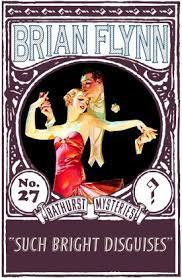
Steve Barge blogs as The Puzzle Doctor and his In Search of the Classic Mystery is one of my favourite crime fiction blogs. His enthusiasm for books he likes is infectious and I am especially impressed by the way he has championed the work of Brian Flynn, an author I must admit to having paid no attention until the past couple of years. Thanks to Steve, the Flynn books have been reissued by Dean Street Press. Flynn was what would now be termed a 'midlist author' - meaning, among other things, that his publishers never bothered much about promoting his work - and it is good that, so many years later, he is now receiving a fair amount of attention.
My eye was caught by discussion of Flynn's 1941 novel Such Bright Disguises and I've just read the book for myself. Steve doesn't discuss the story in his intro, but covered it in a blog post a couple of years back. Two more of my favourite blogs, Mysteries Ahoy! and Pretty Sinister Books have also discussed the story. These three bloggers are good judges (I don't say that merely because I often find myself agreeing with their opinions!) and it's noteworthy that they all have a lot of time for Such Bright Disguises.
This is undoubtedly an interesting and unusual story. The combination of inverted mystery and whodunit is highly intriguing, with several touches of originality. I haven't read much of Flynn, but my strong impression is that he was a very good ideas man. This is an invaluable trait in an author of classic mysteries. There were various highly surprising developments in the narrative which definitely took me aback. Overall, it's an ambitious piece of writing and I find that admirable.
One thing Flynn lacked (like so many authors, past and present) was a high-calibre editor. He was no prose stylist (although I suspect he thought otherwise) and the rapid shifts of viewpoint in some chapters diminish his attempts, praiseworthy as they are, to depict the characters in more depth than is commonly found in many Golden Age mysteries. (there's even a decorous sex scene). We have to digest sentences such as: 'Strange to relate when we recall Hubert, who was their only child, Ralph Grant was a total abstainer.' Some of the clunky writing was surely attributable to Flynn's hurrying too much with his work. He was - like a number of characters in the story - a finance man in local government - and, believe me, I know how difficult it is to combine a busy professional life with writing novels. I just wish he'd considered writing fewer books, and writing them a little more elegantly.
Having had such an excellent idea, brimming with potential, I feel Flynn could have done more with it. The final section is oddly abrupt after a long and elaborate build-up. Faced with two deaths, the police seem to give up right away and call in the private detective Anthony Bathurst to do their work for them. I understand that including Bathurst may have seemed like a commercial imperative, but the haste of the wrap-up was unconvincing and smacks of a surrender to deadline pressure. As a result, this isn't the book it might have been, a masterpiece in the Ironist tradition, as good as anything written by Bruce Hamilton or Richard Hull. However, I don't want to damn this book with faint praise, because it is a striking and genuinely enjoyable read, which I am more than happy to recommend. Dean Street Press and Steve Barge deserve congratulations for making it available once again.
April 14, 2022
The Secret, Landscapers, and The Thief, His Wife, and The Canoe

When you write a screenplay about a real life criminal case (not that I've ever done it!) you have to make choices about how you handle the material. Choices about style, tone, the extent of fidelity to the facts, and so on. Will the story be told chronologically, or in some other way, for example with the discovery of the crime or the arrest of the culprit? How you tackle these questions will determine, to some extent, the success of the end result.
A case in point was The Salisbury Poisonings, which I a couple of years back. That show was much acclaimed, and it did have plenty of merit but I think that with time, its limitations are increasingly evident. In retrospect, its failure to address the reasons for the crime and the Russian background seem, arguably, symptomatic of the attitudes in the West that prevailed prior to the recent invasion of Ukraine. Society didn't look closely enough at what was going on.in Russia.
I've recently watched three very different TV dramas based on real life crimes. One was The Secret, a 2016 series which took a relatively 'straight' approach to the material - a conspiracy by an Irish dentist and his lover to murder their respective spouses. It's an extraordinary case and I felt the writers handled the material very well. The performance of James Nesbitt as the homicidal dentist with supposedly strong religious convictions was especially fine.
Landscapers, starring Olivia Colman and David Thewlis, takes a very different approach. This story of another couple who kill is treated as a black comedy. Again it's been greatly praised, but I must admit to finding the episodic handling of the story as unsatisfactory as its tone. Colman and Thewlis are excellent actors, but I seem to be in a minority in finding the way the crime is handled to be far from appealing.
Rather better, I felt, was The Thief, His Wife and The Canoe, Chris Lang's version of the John Darwin fraud case. It's a fascinating story of a Walter Mitty character, played by Eddie Marslan, and his wife (Monica Dolan: excellent). I once listened to an account of the case by a police officer who was involved with it, and I think that this version owed quite a bit to Chris Lang's imagination. But the characters seemed to be treated with greater respect than in Landscapers and I enjoyed it.
April 13, 2022
100 British Library Crime Classics
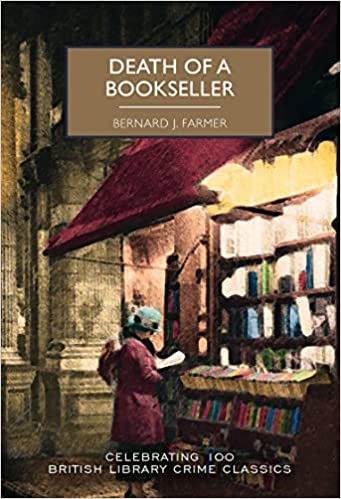
The one hundredth British Library Crime Classic has now been published. The title in question was, appropriately enough, a 'bibliomystery', Bernard J. Farmer's Death of a Bookseller, complete with a message on the inside cover from me to series fans. My association with the series dates back to July 2013, when I first met the then publisher, Rob Davies, who asked me to write intros for a couple of forthcoming titles by John Bude. I'd been writing intros for republished crime novels since the mid-90s, but it's fair to say that none had come close to the bestseller lists. And neither Rob nor I dreamed that the series would become such a runaway success.
It's interesting for me to cast my mind back to that stage in my career. I'd just published my sixth Lake District Mystery, The Frozen Shroud, but I was still a partner in my firm (although by that stage working four days a week). I was hard at work on The Golden Age of Murder, a project which had occupied me for years, and it seemed far from certain that book would even find a publisher. Suffice to say that the intervening years have been kind and the Crime Classics have certainly played a part in my enjoyment of that time. Many have followed in the British Library's footsteps, sometimes splendidly, sometimes not quite so splendidly. From my point of view, it's marvellous to see so many long-neglected books becoming available again at affordable prices. The series' influence on the wider publishing world has been quite remarkable. Meanwhile my postbag (and the sales figures) indicate little doubt that the Crime Classics remain comfortably ahead of the field.
There have been many British Library-related highlights for me during the past nine years. I loved being given the chance to write a new solution to Anthony Berkeley's The Poisoned Chocolates Case: short as it is, I've been gratified by the response from reviewers and readers. The same is true of reaction to the eighteen anthologies (with two more on the way) that I've edited for the series. My companion volume to the series, The Story of Classic Crime in 100 Books, was nominated for five awards and won one; among other things, it's now been translated into Korean and Chinese. I designed a murder mystery for a pop-up shop at the Library one Christmas and I've also held a weekend masterclass on classic fiction there and been interviewed in the Library's Conference Centre, with Ann Cleeves, by Mark Lawson. There have been lots of other events, including last year's lovely visit to Ely, with more in the pipeline. I'd like to pay tribute to Rob and his successors at the Library and express my thanks for their encouragement and faith in my suggestions..
Today the Crime Classics are famous enough to merit a mention in Anthony Horowitz's Moonflower Murders. All this demonstrates how much people enjoy a well-made and entertaining story. I certainly don't choose all the titles or authors for the series, but I'm glad to have played a particular part in the rediscovery of interesting novels by such varied writers as E.C.R. Lorac, Mary Kelly, John Dickson Carr, Richard Hull, C.E. Vulliamy, Anne Meredith, Peter Shaffer, Christianna Brand, Nap Lombard, Raymond Postgate, and Margot Bennett. Do I admire every single book in the series equally? Of course not; the range is, quite deliberately, too diverse for that. Do I think that the series has made a wonderful contribution to readers' pleasure across the world? Absolutely.
April 11, 2022
A Visit to Kent

I had a wonderful time last week on a short but very packed visit to Kent. I was hoping to combine pleasurable socialising with research into some aspects of British crime writing heritage, but I didn't know exactly what to expect. As things turned out, I met some truly delightful people as well as a couple of friends who happen to be crime writers for whom I've a huge amount of admiration.
In Deal - a resort I'd never visited before - I had the pleasure of spending time with Frances Fyfield, a fellow lawyer as well as one of the finest British crime novelists of the past thirty years. She's always great company and an added bonus was that she threw a party for a friend and neighbour which led to my meeting a host of interesting people, including Nick Dear, whose highly successful plays include Frankenstein and whose TV work includes half a dozen episodes of Poirot. Deal obviously has a very cohesive literary community as well as two castles, and I was definitely impressed.
I also had the chance to visit Catherine Aird, who lives just outside Canterbury. Another real pleasure. Catherine is, I'm glad to report, working hard on her latest novel and at the same time turning her mind to the next. The passing years have diminished neither her wit nor the fertility of her imagination - she outlined a plot idea that I felt was really appealing. I wish I'd thought of it...
In addition I had the good fortune to be able to meet friends and family of Julian Symons. This was fascinating and I learned more about a writer in whom I've long been very interested. It was great to see the British Library editions of his books lined up the shelves along with his first editions. And not to mention the Edgars - see below!
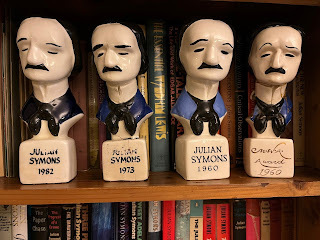
Finally, there was the opportunity for a small amount of sightseeing and I wandered along the front at Walmer (where Symons used to live) and also around the lovely old town of Sandwich. And no, I didn't get to eat a sandwich there...
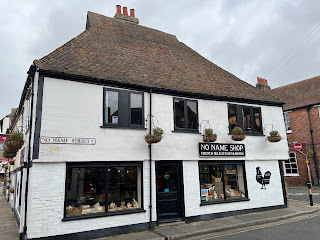
April 8, 2022
Forgotten Book - Mischief in the Offing
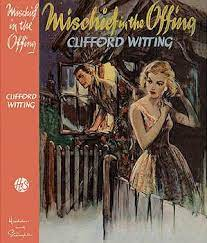
Sussex isn't a county that I know particularly well, but during my last two visits to Rye, I've made a point of travelling round and enjoying the county's coastline and the rural landscape. It's a nice part of the world, for sure. So I was tempted by the setting of Clifford Witting's Mischief in the Offing. The action of the story takes place in Wilchiston, a thinly veiled version of the village of Alfriston.
The story begins with the arrival of a strange visitor at John Denman's cottage. An attractive young woman called Kay Forrester turns up, seeking sanctuary. She claims to have been molested by a man with a gun. John is a likeable fellow, but he soon has reason to believe that she isn't telling him the truth. And then a shot is fired at the cottage.
This is a good start, but after that the pace falters, to put it mildly. Witting's writing style can fairly be described as discursive, but here 'rambling' might be a better word. There's a lack of focus in the storyline and I found it difficult to care much about what was happening. Yet there are compensations, including the agreeable presentation of rural life (including a game of stoolball) and touches of Witting's amiable humour.
This book appeared in 1958, at the time Witting was elected to membership of the Detection Club, and there are one or two nice plot features, including a revelation in the final sentence. For me, though, the story lacked tension. I like the fact that Witting was not content to rest on his laurels as a writer, and didn't keep resorting to the same-old,same-old. But this one is a decidedly minor entry in his catalogue.
April 6, 2022
I Care a Lot - 2020 film review

I Care a Lot is a fairly recent film which blends thriller elements with black humour and makes a few s stinging points about capitalism along the way. Because it's set in the US, I was surprised to learn that the writer-director, J. Blakeson (Jonathan Blakeson) is English, born in Harrogate and educated at Warwick. Overall, I think he does a good job, because despite various flaws, this is an entertaining and watchable movie which is especially good in the early scenes.
Rosamund Pike is Marla Grayson, who - assisted by Fran (Eiza Gonzalez) - works as a court-appointed guardian of old people who are incapable of looking after their own affairs. It soon becomes clear that Marla targets wealthy individuals whose assets she can sell and profit from. This very lucrative business is supported by a lax judiciary and corrupt medical profession. It's all the more horrific because it seems believable.
Things start to get complicated when she picks on a perfectly healthy old lady who lives on her own. This is Jennifer Peterson, played by Dianne Wiest. Marla manages to get Jennifer confined to a hospital, having conned a judge (with the help of false medical information) that Jennifer can't look after herself. It soon becomes clear, however, that this time Marla might have bitten off more than she can chew. Jennifer is not the sweet innocent she appears to be...
There are some funny scenes involving a Mafia lawyer called Dean Ericson (Chris Messina) which I found truly enjoyable highlights. Peter Dinklage is also good as a bad guy who makes a formidable adversary for Marla. But it's Rosamund Pike who holds the film together, even when the script begins to wander in a rather unconvincing way. The climax to the story doesn't appeal to everyone, and it's not overly subtle, but on the whole I think it worked. An entertaining film which, every now and then, makes you think about how society treats vulnerable people.



